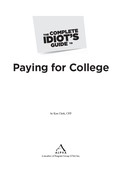Tuition Reward Credit Cards
In addition to UPromise and BabyMint both offering their own branded credit cards, a number of other options are out there that aren’t tied to one of these reward programs. For a family that is a heavy user of credit cards, earning 1 percent or more on your purchases can easily rack up $1,000 or more a year in tuition. Of course, this can be easily offset by carrying a balance and paying 20 to 30 percent in annual interest, so I do not recommend starting to use a new card if you are not already showing good discipline in using the one you have.
Additionally, credit cards that reward their users with tuition need to be compared against other credit cards with other nontuition reward programs. You can do this by simply calculating the net benefit you receive for the amount of money you spend on the card annually. For example, if you receive $500 in cash back from a card that also costs you $100 per year, your net benefit is $400. If you had to spend $20,000 to earn that $400 after fees, your reward ratio is 2 percent ($400 divided by $20,000). If this is what your existing card earns you, and a college tuition card offers only 1 percent, obviously you shouldn’t switch.

WORLD WIDE WISDOM
Before you run out and sign up for a new credit card, spend some time surfing the Web for the fine print and third-party ratings on the various cards. One of the best websites for finding the right credit card is CardRatings.com.
With all of that in mind, here are some of the most popular college tuition credit cards. Keep in mind that the fine print of these cards might have changed since the book was published:
• Fidelity 529 credit card—This card rewards you by depositing 2 percent of your purchases into any Fidelity 529 account. Even better, if friends and family sign up for the card, they can earn tuition for your child as well.
• Bank of America UPromise credit card—This card, which is linked to your UPromise account, pays 1 percent on most purchases, 2 percent on gas from certain companies, and up to 10 percent on certain items at the grocery or drug store.
• BabyMint Platinum Visa—Similar to the UPromise card, the BabyMint Visa is linked to your BabyMint account, depositing your rewards as you earn them. For families not heavily using the BabyMint savings program, this card may not be as attractive as the Fidelity or UPromise card because it pays only a flat 1 percent on purchases, with no bonus opportunities.
• FutureTrust Mastercard—The FutureTrust MasterCard does exactly what the BabyMint credit card does, awarding you 1 percent on your purchases. Because this is a much smaller program than UPromise and BabyMint, this card is most likely to be a best choice only for those that primarily use the other features of the FutureTrust savings program.
• Nontuition credit cards—Consider looking at what other nontuition-based credit cards have to offer, especially from the Discover Card family. Often, the rewards on these cards are heftier, with additional perks like waived interest for paying on time (for example, the Discover Motiva card). These cards might save you more than you’d earn by using one of the other cards that promises to help you pile up tuition dollars.
The Least You Need to Know
• Everyone should be using tuition reward programs, regardless of where they are in the process of paying for college.
• Getting family and friends to participate can turbo-charge the rate at which you accumulate rewards.
• Maximize programs such as UPromise and BabyMint by planning your seasonal shopping and largest purchases in advance.
• Review the current list of schools participating in the SAGE Scholars Program to see whether you should sign up.
• If you’re a frequent credit card user, consider signing up for a card that earns you tuition instead of points or miles.
..................Content has been hidden....................
You can't read the all page of ebook, please click here login for view all page.
